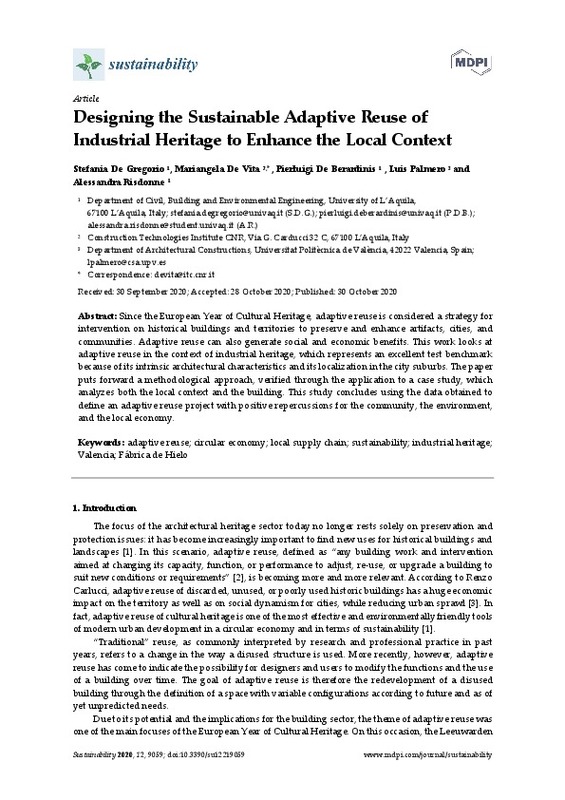Orientamenti Europei per Sostenere il Riutilizzo Adattivo Degli Edifici Storici nel 2019–2020https://www.archeomatica.it/editoriali/orientamenti-europei-per-sostenere-il-riutilizzo-adattivo-degli-edifici-storici-nel-2019-2020
Leeuwarden Declaration 2018https://www.ace-cae.eu/activities/events/2018/built-heritage-conference/
Trizio, I., De Vita, M., Ruggieri, A., & Giannangeli, A. (2020). THE ARCHAEOLOGICAL PARK OF NAVELLI (ITALY) IN THE RECONSTRUCTION PLAN: HYPOTHESIS OF ADAPTIVE REUSE. The International Archives of the Photogrammetry, Remote Sensing and Spatial Information Sciences, XLIV-M-1-2020, 929-936. doi:10.5194/isprs-archives-xliv-m-1-2020-929-2020
[+]
Orientamenti Europei per Sostenere il Riutilizzo Adattivo Degli Edifici Storici nel 2019–2020https://www.archeomatica.it/editoriali/orientamenti-europei-per-sostenere-il-riutilizzo-adattivo-degli-edifici-storici-nel-2019-2020
Leeuwarden Declaration 2018https://www.ace-cae.eu/activities/events/2018/built-heritage-conference/
Trizio, I., De Vita, M., Ruggieri, A., & Giannangeli, A. (2020). THE ARCHAEOLOGICAL PARK OF NAVELLI (ITALY) IN THE RECONSTRUCTION PLAN: HYPOTHESIS OF ADAPTIVE REUSE. The International Archives of the Photogrammetry, Remote Sensing and Spatial Information Sciences, XLIV-M-1-2020, 929-936. doi:10.5194/isprs-archives-xliv-m-1-2020-929-2020
Romeo, E., Morezzi, E., & Rudiero, R. (2015). Industrial Heritage: Reflections on the Use Compatibility of Cultural Sustainability and Energy Efficiency. Energy Procedia, 78, 1305-1310. doi:10.1016/j.egypro.2015.11.145
Blagojević, M. R., & Tufegdžić, A. (2016). The new technology era requirements and sustainable approach to industrial heritage renewal. Energy and Buildings, 115, 148-153. doi:10.1016/j.enbuild.2015.07.062
Ifko, S. (2016). Comprehensive Management of Industrial Heritage Sites as A Basis for Sustainable Regeneration. Procedia Engineering, 161, 2040-2045. doi:10.1016/j.proeng.2016.08.800
Liu, F., Zhao, Q., & Yang, Y. (2018). An approach to assess the value of industrial heritage based on Dempster–Shafer theory. Journal of Cultural Heritage, 32, 210-220. doi:10.1016/j.culher.2018.01.011
Xie, P. F. (2015). A life cycle model of industrial heritage development. Annals of Tourism Research, 55, 141-154. doi:10.1016/j.annals.2015.09.012
Florentina-Cristina, M., George-Laurenţiu, M., Andreea-Loreta, C., & Constantin, D. C. (2014). Conversion of Industrial Heritage as a Vector of Cultural Regeneration. Procedia - Social and Behavioral Sciences, 122, 162-166. doi:10.1016/j.sbspro.2014.01.1320
Martínez Pino, J. (2018). The New Holistic Paradigm and the Sustainability of Historic Cities in Spain: An Approach Based on the World Heritage Cities. Sustainability, 10(7), 2301. doi:10.3390/su10072301
Foster, G. (2020). Circular economy strategies for adaptive reuse of cultural heritage buildings to reduce environmental impacts. Resources, Conservation and Recycling, 152, 104507. doi:10.1016/j.resconrec.2019.104507
https://itaca.org/valutazione_sostenibilita.asp#
Adams, K. T., Osmani, M., Thorpe, T., & Thornback, J. (2017). Circular economy in construction: current awareness, challenges and enablers. Proceedings of the Institution of Civil Engineers - Waste and Resource Management, 170(1), 15-24. doi:10.1680/jwarm.16.00011
Ayres, R. U. (1999). The second law, the fourth law, recycling and limits to growth. Ecological Economics, 29(3), 473-483. doi:10.1016/s0921-8009(98)00098-6
Bullen, P. A., & Love, P. E. D. (2011). Adaptive reuse of heritage buildings. Structural Survey, 29(5), 411-421. doi:10.1108/02630801111182439
https://ec.europa.eu/jrc/en/pvgis
Frosch, R. A., & Gallopoulos, N. E. (1989). Strategies for Manufacturing. Scientific American, 261(3), 144-152. doi:10.1038/scientificamerican0989-144
https://www.worldgbc.org/news-media/2019-global-status-report-buildings-and-construction
Baker, H., Moncaster, A., & Al-Tabbaa, A. (2017). Decision-making for the demolition or adaptation of buildings. Proceedings of the Institution of Civil Engineers - Forensic Engineering, 170(3), 144-156. doi:10.1680/jfoen.16.00026
Ghisellini, P., Ripa, M., & Ulgiati, S. (2018). Exploring environmental and economic costs and benefits of a circular economy approach to the construction and demolition sector. A literature review. Journal of Cleaner Production, 178, 618-643. doi:10.1016/j.jclepro.2017.11.207
Keeble, B. R. (1988). The Brundtland report: ‘Our common future’. Medicine and War, 4(1), 17-25. doi:10.1080/07488008808408783
[-]









